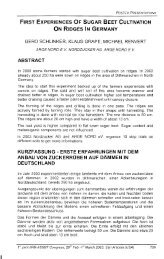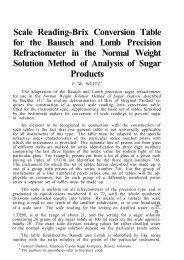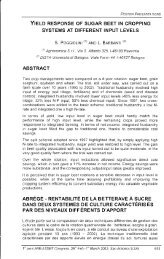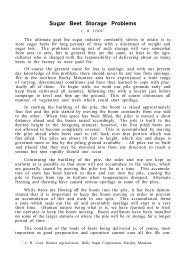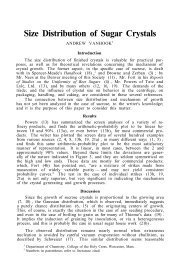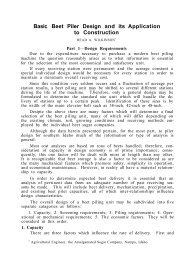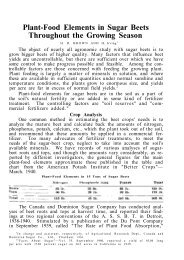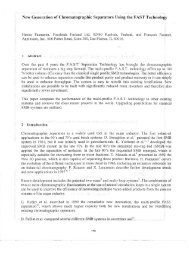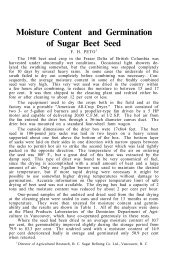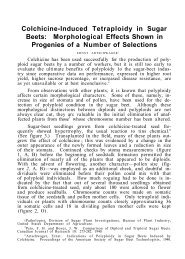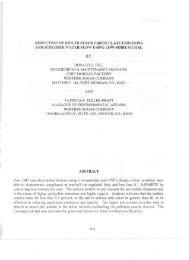Some illustrations of methods in plant breeding - ASSBT Proceedings
Some illustrations of methods in plant breeding - ASSBT Proceedings
Some illustrations of methods in plant breeding - ASSBT Proceedings
Create successful ePaper yourself
Turn your PDF publications into a flip-book with our unique Google optimized e-Paper software.
yet. True, the science <strong>of</strong> genetics is still young and grow<strong>in</strong>g. I<br />
trust that the day \'rill come \'/hen hwnani ty will take as great an <strong>in</strong>ter..o.<br />
est <strong>in</strong> the creation <strong>of</strong> superior forms <strong>of</strong> life as it has taken <strong>in</strong> past<br />
years <strong>in</strong> the perfection <strong>of</strong> superior forms <strong>of</strong> mach<strong>in</strong>ery. In the long<br />
run superior life forms ma.y prove to have a greater pr<strong>of</strong>it for mank<strong>in</strong>d<br />
than mach<strong>in</strong>ery • 11<br />
Standardization <strong>of</strong> Breed<strong>in</strong>g ~ifethods<br />
While ne\'l technics <strong>in</strong> <strong>plant</strong> breed<strong>in</strong>g are be<strong>in</strong>g developed from year to<br />
year, certa<strong>in</strong> standardized <strong>methods</strong> ~~ve been developed for particular categories<br />
<strong>of</strong> crop <strong>plant</strong>s and for specialized problems. These can be illustrated<br />
best, I th<strong>in</strong>k, <strong>in</strong> rela.tion to their application.<br />
There is a close relation bet\'leen <strong>methods</strong> <strong>of</strong> breed<strong>in</strong>g and normal mode<br />
<strong>of</strong> poll<strong>in</strong>ation. Four subdivisions are <strong>of</strong> major importance altho there is no<br />
sharp division between classes.<br />
1. Naturally self poll<strong>in</strong>ated (4% or loss <strong>of</strong> cross poll<strong>in</strong>ation). Barley,<br />
\·Theat, oats, tobacco, potatoes, flax, rice, peas, beans, soybeans, cowpeas.<br />
2. Often cross poll<strong>in</strong>ated (self poll<strong>in</strong>ation ) cross poll.) Cotton, sorghums,<br />
some stra<strong>in</strong>s <strong>of</strong> sweet clover.<br />
3• Naturally cross poll<strong>in</strong>ated.<br />
Maize, rye, clovers, sugar beets, cucurbits, most perennial grasses.<br />
Self sterile <strong>plant</strong>s.<br />
4. Dioecious. Hops, hemp, sp<strong>in</strong>ach, asparagus.<br />
l'l'i th this classification as a background it seems logical to outl<strong>in</strong>e<br />
some standardized <strong>methods</strong> <strong>of</strong> breed<strong>in</strong>g for particular problems <strong>in</strong> relation to<br />
the biology <strong>of</strong> the <strong>plant</strong> and the type <strong>of</strong> improvement soughto Many changes <strong>of</strong><br />
viewpo<strong>in</strong>t have taken place dur<strong>in</strong>g tho 30 years that I have been actively<br />
engaged <strong>in</strong> studies <strong>of</strong> genetics ro1d <strong>plant</strong> breed<strong>in</strong>g. Early <strong>in</strong> this period it was<br />
<strong>of</strong>ten stated that <strong>plant</strong> breed<strong>in</strong>g was largely an art. Vlhile reco&J,i z<strong>in</strong>g the<br />
importance <strong>of</strong> the art I shall try to emphasize the value <strong>of</strong> aknowledge <strong>of</strong><br />
genetics <strong>in</strong> its application to problems <strong>of</strong> crop improvement. About 1915,<br />
Dr. Raymond Pearl stated that the breeder <strong>of</strong> the self-poll<strong>in</strong>ated group <strong>of</strong> <strong>plant</strong>s<br />
used Mendel's Lav.rs as a direct and '"ork<strong>in</strong>g guide. In so do<strong>in</strong>g the first<br />
standa.rdi zed breed<strong>in</strong>g program came to be designated as 11 the pedigree m ethod. 11<br />
It consists <strong>of</strong> mak<strong>in</strong>g a cross between parent l<strong>in</strong>es that differ <strong>in</strong> several<br />
important characters follov..red by selection, dur<strong>in</strong>g the segregat<strong>in</strong>g generations,<br />
for the comb<strong>in</strong>ation <strong>of</strong> characters desired. Many <strong>of</strong> the cha.racters <strong>of</strong> selection<br />
value will be related to yield<strong>in</strong>g ability. There \•rill be other genetic factors<br />
for yielcli,ng ability tha.t can 'be selected by the breeder only through field<br />
trials <strong>of</strong> sufficient numbers, under proper <strong>methods</strong> <strong>of</strong> experimental design, so<br />
t~~t the higher yield<strong>in</strong>g stra<strong>in</strong>s can be selected on the basis <strong>of</strong> their performance.<br />
Cross<strong>in</strong>g Followed by Selection Dur<strong>in</strong>g Segregat<strong>in</strong>g Generations<br />
The breed<strong>in</strong>g program can be summarized as follO\'lS!<br />
The pedigree method<br />
1. Select<strong>in</strong>g the parents with the vie\'l <strong>of</strong> comb<strong>in</strong><strong>in</strong>g; their desirable characters



